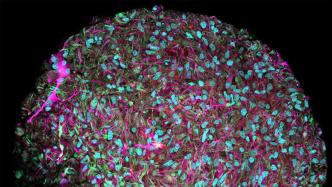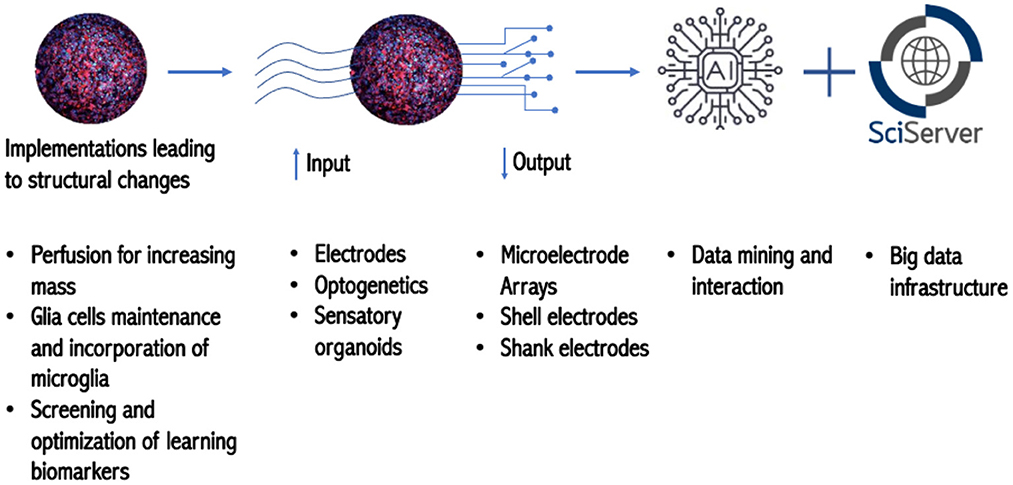
Artificial intelligence (AI) has long been inspired by aspects of the structure and workings of the human brain, and AI has achieved an impressive array of feats, from assisting diagnostic medicine to composing poetry. Still, the original model—the human brain—still outperforms machines in many ways.
On February 28, Johns Hopkins University (Johns Hopkins University) released a message saying, what if we don’t try to make AI more like the brain, but go straight to the source? Scientists across multiple disciplines are working to create revolutionary "biocomputers," using three-dimensional cultures of brain cells called organoids as hardware.
On February 28, the researchers published a paper titled "First Organoid Intelligence (OI) Symposium on Establishing the Organoid Intelligence Community" (First Organoid Intelligence ( OI) workshop to form an OI community) article describing a roadmap to realize this vision .
"We call this new interdisciplinary field 'organoid intelligence' (OI)," said corresponding author Thomas Hardon, a professor at the Johns Hopkins University Bloomberg School of Public Health in the United States. Hartung) said.

"Organoid Intelligence" Roadmap.
First Organoid Intelligence Symposium, Community and Manifesto
According to the above article, after realizing the great potential of organoid research, Johns Hopkins University in the United States organized the first organoid intelligence seminar from February 22 to 24, 2022, thus forming a Organ Intelligence (OI) research community, and adopted the Baltimore Declaration on Exploring Organoid Intelligence.
The above article was submitted on December 5, 2022, ten months after the first symposium, accepted on February 8, 2023, and published online on February 28.
The manifesto calls on the international scientific community to explore the potential of human brain-based organoid cells to advance our understanding of the brain and explore new forms of biological computing, while recognizing and addressing associated ethical issues. In a manner consistent with the term AI (Artificial Intelligence), participants at the conference coined the term "Organoid Intelligence" (OI) to describe this research and development approach. "Artificial intelligence" is used to describe the ability of computers to perform tasks that normally require human intelligence. OI has the potential for broad and far-reaching applications to benefit humanity and our planet.
OI holds promise for elucidating the physiology of human cognitive functions such as memory and learning, the manifesto says. It offers game-changing opportunities for biological and hybrid computing that can overcome significant limitations of silicon-based computing. It offers the prospect of unprecedented advances in the interface between brain and machine. Finally, OI could lead to breakthroughs in modeling and treating dementia and other neurogenetic diseases, which cause a large and growing disease burden worldwide. Realizing OI's world-changing potential will require scientific breakthroughs. We need advances in human stem cell technology and bioengineering to recreate the structure of the brain and mimic its underlying pseudocognitive abilities. We need breakthrough interface technologies that allow us to pass input signals to organoids, measure output signals, and employ feedback mechanisms to simulate the learning process. We also need new machine learning, big data, and artificial intelligence techniques to allow us to understand brain organoids. In addition to addressing these scientific and technical challenges, we also need to anticipate (as much as possible) and address ethical challenges relevant to this research and largely unexplored. We must be alert to any possibility of organoids developing forms or aspects of consciousness, and to mitigate and guard against this. We call on the scientific community to join us on this journey. Only by working together can we realize the full potential of OI to advance science, technology and medicine.
That is to say, the organoid intelligence project includes at least four aspects: through the advancement of human stem cell technology and bioengineering to reconstruct the brain architecture and model its cognitive potential; Organs transmit input signals, measure output signals, and use feedback mechanisms to simulate the learning process; through novel machine learning, big data, and AI technologies, people can understand brain organoids; discuss a consensus in the development of organoid intelligence ethical framework.

Cell staining photos of brain organoids (pink - neurons; red - oligodendrocytes; green - astrocytes; blue - nuclei), from the laboratory of Thomas Hartung, Johns Hopkins University, USA.
From cells to organoid intelligence
Computing and artificial intelligence have been driving technological revolutions, but they are reaching a ceiling, according to Professor Thomas Hartung, one of the leaders of the aforementioned research programme. So back in 2012, Hartung's lab began reprogramming cells from human skin samples into an embryonic stem cell-like state, culturing brain cells and assembling them into functional organoids. Each such organoid contains about 50,000 cells.
A "biocomputer" powered by human brain cells could be developed within our lifetimes, according to a research team. These brain organoids are the size of the tip of a pen.
Brain organoids are laboratory-grown cell cultures. Although it is not a "mini-brain", it has key aspects of brain function and structure, such as housing neurons and other brain cells that are critical for cognitive functions such as learning and memory. Also, while most cell cultures are flat, the organoids have a three-dimensional structure that increases their cell density by a factor of 1,000, meaning that neurons in brain organoids can form more connections.
Aren't computers smarter and faster than brains?
"While silicon-based computers are better at numbers, the brain is better at learning", explains Hartung. Not only are brains great learners, they are also more energy efficient. For example, it took more energy to train AlphaGo than it takes to sustain an active adult for ten years.
Hartung added, "We are reaching the physical limits of silicon-based computers because we cannot pack more transistors into a tiny chip. But the brain is wired in a completely different way. It has about 100 billion neurons. "
Neurons are connected by a large number of connection points, "compared with our current technology, there is a huge difference in power ," Hartung said. "The brain also has an amazing information storage capacity, estimated at 2500TB (note: 1TB = 1024GB)."

Professor Thomas Hartung of the Johns Hopkins University Bloomberg School of Public Health holding a brain organoid culture plate.
According to Hartung, current brain organoids are too small, "each containing about 50,000 cells. For OI, we need to increase this number to 10 million," he explained.
At the same time, the authors are also developing techniques to communicate with the organoids: in other words, send them messages and read out their "thoughts."
"We developed a brain-computer interface device, which is an organoid EEG cap, which we described in an article published last August. It is a flexible shell densely covered with tiny electrodes that can both receive signals from the organoid and transmit signals to it," Hartung said.
The authors envision that eventually OI will integrate different stimulation and recording tools, as well as the interaction of organoid networks, enabling more complex computations.
"With OI, we can also study the cognitive aspects of neurological disorders," says Hartung. "For example, we can compare memory formation in organoids from healthy people and Alzheimer's patients and try to repair relative deficits. We can also use OI to test whether certain substances, such as pesticides, cause memory or learning problems."
Although OI is still in its infancy, one of the paper's co-authors, the undersigned, provided a proof of concept for a recently published study by Dr Brett Kagan of the Australian Cortex Laboratory. His team has published a paper showing that cultures of normal, flattened brain cells can learn to play the video game Pong.
"I would say that replicating this experiment with organoids has satisfied the basic definition of OI. From now on, it is only necessary to build the community, tools and technology to realize the full potential of OI," Hartung concluded.


